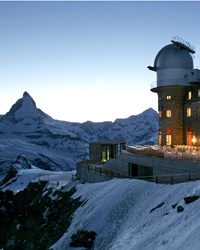 Catch amazing views at these sky-high mountain lodges and skyscraper hotels.
Catch amazing views at these sky-high mountain lodges and skyscraper hotels.
See our slideshow of the World’s Highest Hotels.
High in Peru’s Andes Mountains, nearly 8,000 feet above sea level, you start to feel the onset of what locals call mal de montaña—altitude sickness. Your head pounds, your body feels weak, and your fellow traveler’s annoyingly dumb jokes suddenly seem hilariously funny. The spectacular view from your mountainside perch—over Putucusi, or “Happy Mountain,” a jungle thick with orchids, and the angular, Tetris-like ruins of Machu Picchu—begins to seem dizzying.
Luckily, all you have to do is call room service. Within minutes, the staff at the Machu Picchu Sanctuary Lodge will deliver steeped coca leaves, a local cure-all with a green tea–like taste, and the fog in your head will lift. Then you’ll realize once again how perfect your whereabouts are: you’re cocooned in comfort, but still on top of the world.
Machu Picchu Sanctuary Lodge is just one of many high-altitude and skyscraper hotels where a bird’s-eye view is the number-one selling point. Who can blame travelers for wanting to ditch “garden-view” and “pool-view” rooms in favor of a view of the Matterhorn or the Shanghai skyline?
“People are always looking for indelible memories, and there’s nothing like a dramatic setting,” says Jaume Tàpies, international president of Relais & Châteaux, an association of hotels with high-altitude getaways from Monaco to New Zealand. “Our guests vie for locations providing extraordinary views—so much so that our highest properties are often booked a year in advance.”
Sometimes the biggest challenge of staying in a sky-high hotel isn’t landing a reservation or adjusting to the altitude, but actually getting there. Guests at Whare Kea Chalet in New Zealand, for example, can access their lodgings only via private helicopter; visitors to Switzerland’s 3100 Kulmhotel Gornergrat arrive after a steep climb on a narrow-gauge railroad. You can steer your own car to the Far View Lodge in Mesa Verde National Park, Colorado, but you’ll be squeaking around cliff-side hairpin turns en route. And at Yeti Mountain Home Kongde, a new Nepalese spot that, at 13,900 feet, is the highest in the Himalayas, helicopters can be arranged—but the ecologically minded owners prefer you arrive on foot with the help of local guides.
Why are we willing to risk vertigo to stay in such places?Stacy Allison, the human skyscraper who in 1988 became the first female American to summit Mount Everest, has some ideas. For some people, Allison says, high hotels give the feeling of adventure, without the hardships that go along with it. Also, she says, “many cultures believe gods live on mountaintops—so mystics and enlightened people are naturally drawn there.”
Sandy Liu, a spokesperson for the Park Hyatt Shanghai—currently the world’s tallest hotel—says culture can be a factor, too: “In the Chinese way of thinking,” Liu says, “being high above is a symbol of prosperity and wealth.”